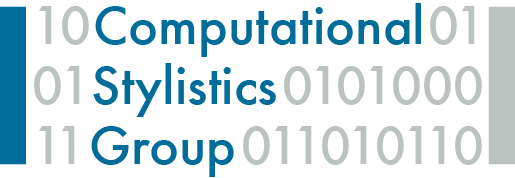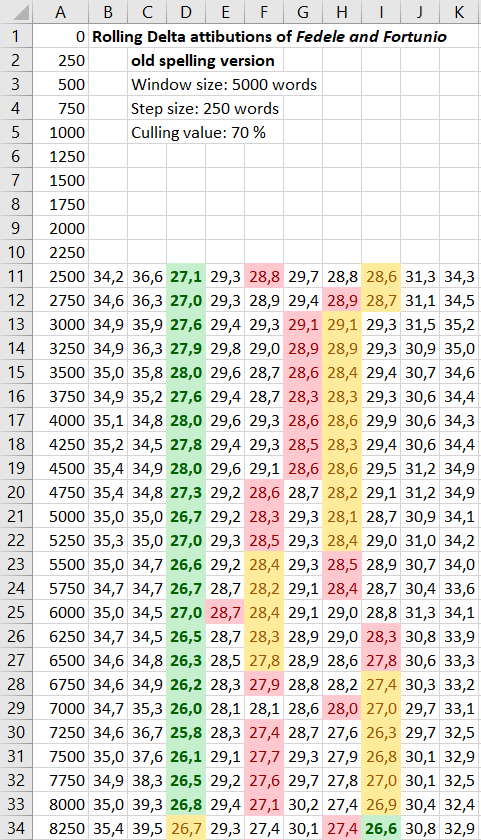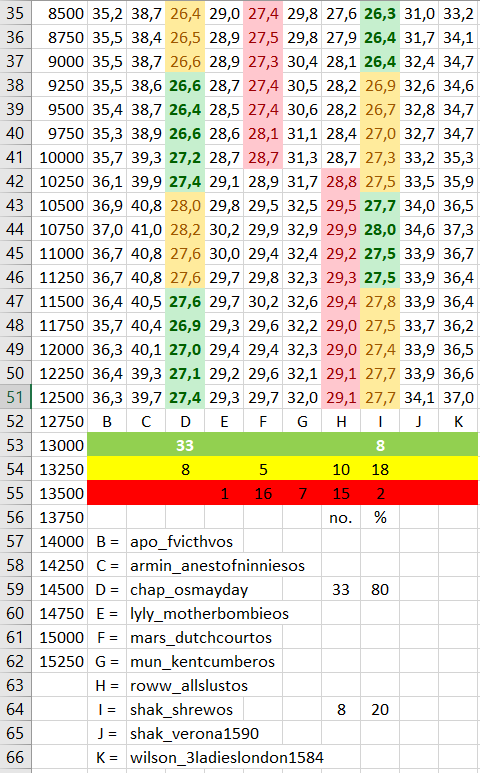Shakespeare Statistics
Autorship of Fedele and Fortunio
 auf deutsch
All data were generated witht R Stylo, see:
auf deutsch
All data were generated witht R Stylo, see: 
There are two names in the secondary literature that are associated with Fedele and Fortunio.
J. Payne Collier named Anthony Munday in 1831, relying on the initials A.M. of his Collier-Huntington
copy, with which the dedication of the 1585 quarto was signed. Richard Hosley, who wrote an essay
entitled "The Authorship of Fedele and Fortunio" in 1967, names a number of other scholars who
supported this attribution: Thomas Marc Parrott (1915), W.J. Lawrence (1920), M. St. Clare Byrne
(1920), Celeste Turner (1928) and I.A. Shapiro (1961) (Hosley, p. 315-316).
However, there were also dissenting voices, such as that of Walter W. Greg, who considered the
dedication with the initials A.M. to be another forgery by Collier, as it was not included in the
quarto (Devonshire-Folger copy) available to him, and he recognised documents by Charles Crawford
in favour of George Chapman as being of higher quality. Frederick S. Boas then discovered the
aforementioned dedication in another copy (Mostyn-Folger copy) in 1919, but with the initials M.A.
instead of A.M. and the text was dedicated to Master M.R., Esquire. Greg questioned the inference
that M.A. or A.M. referred to the author of Fedele and Fortunio, citing an argument made by
Chambers in his work The Elizabethan Stage, namely that an author would not praise his own work
in a dedication, as the epistle explained:
I commende to your freendly viewe this prettie Conceit, as well for the invention, as the delicate
conveiance thereof: not doubting but you will so esteeme thereof, as it doth very well deserve, and
I hartely desire (Chambers, vol. I, p.14, zitiert nach Hosley, S. 319).
But even this assessment was surpassed by a counter-argument arising from the interpretation of the
word "conveyance". This meant the original design by Pasqualigo, entirely in the sense of the OED
as "disposition of material."
Hosley also finds some arguments in favour of Munday. In terms of style measurements, the manner of
his spelling should be mentioned, as can be found in John a Kent and John a Cumber, but also in Sir
Thomas More. Hosley cites research by Miss Byrne, who lists seventeen typical ways of writing for Munday:
„abooue, doouve, looue, mooue, prooue, affoord, boord, swoord, woord, woork, woorship, woorth, foorth, doone, doost, dooth
and freend.“ (Hosley, S. 323).


Here, however, the lowest delta values point to Chapman instead of Munday. Chapman comes also into play
through the assessment of Crawford, who perused England's Parnassus by Robert Allot from 1600 and
emphasised the close friendship between Allot and Chapman. Chapman not only showed Allot papers from
Marlowe's estate to complete Hero and Leander, but also entrusted him with his authorship of Two
Italian Gentlemen, the alternative title of Fedele and Fortunio (Crawford, p. xxix).
.
Compare this evaluation with that in modern spelling and the
results of Rolling Classify, PCA
and GI.
 auf deutsch
All data were generated witht R Stylo, see:
auf deutsch
All data were generated witht R Stylo, see: 
 auf deutsch
All data were generated witht R Stylo, see:
auf deutsch
All data were generated witht R Stylo, see: 

